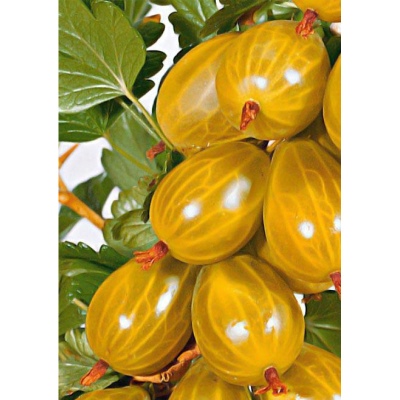
- Growth type: vigorous
- Description of the bush: compact, slightly spreading
- Thorniness: medium
- Thorns: small, single
- Sheet: large
- Berry size: large
- Berry weight, g: 5-10
- Berry shape: rounded oval
- Berry color: Orange
- Skin : thin, translucent, with fine veins
Few people know that today there are more than one and a half thousand varieties of gooseberries. And this number is only increasing, new varieties are being created. Therefore, it is so important to preserve valuable crops that have been bred for a long time. These include Golden gooseberries. This telling name reflects not only the impressive external data of the culture, but also the mood that is created by the sweet taste of the fruit. This gooseberry is popularly called the northern grape.
Breeding history
The golden gooseberry was created in Michurinsk about 25 years ago. The culture was taken out for cultivation in central Russia, as it perfectly withstands frosts down to -25 ° C, but at lower temperatures it can freeze out. The authors of the Zolotisty variety were breeders from the V.I. I. Michurin, however, culture has not yet been entered into the State Register.
Description of the variety
Gooseberry bush Golden high, but rather compact in volume, slightly spreading. The maximum height of the shrub can reach one and a half meters. There are small thorns, but they are solitary, do not greatly interfere with harvesting.
Other pluses of culture:
- large-fruited berries;
- winter hardiness, the ability to withstand frost;
- decorative appearance (can decorate any area);
- picky about leaving;
- rarely suffers from pest attacks;
- gives a rich harvest from 3 years after planting.
Characteristics of berries
Rounded-oval gooseberries Golden large, their weight is in the range of 5-10 grams. The berries have a thin translucent skin with a beautiful and rich orange color.
Taste qualities
Many people note the uniqueness of the honey taste of the Golden gooseberry. It is good both fresh and as part of an unusually tasty jam. And also these are useful compotes, sauces, desserts: due to the high content of vitamin C, the product removes radionuclides from the human body, helps in restoring the digestive system, intestinal motility.
Ripening and fruiting
Golden is a mid-season crop. The start of fruiting occurs in the last July decade, sometimes it is the beginning of August
Yield
Due to its large fruit size, as well as high yield in the amount of 4-5 kg per bush, the variety is quite suitable for mechanized harvesting using special combines.
Growing regions
For the most part, the variety grows, bringing a good harvest, in the center of Russia, as well as in its middle zone.
Landing
It is better to plant Golden gooseberries in an open area, illuminated by the sun, but the plant grows no less well in partial shade. If you plan to plant several bushes, you should maintain a distance of 0.8-1.2 meters between them. From other vegetation, as well as walls, buildings, fences, it is necessary to measure a distance of at least 2 meters.
It is very important when choosing a place for planting to ensure that the crop is protected from drafts and strong winds. Groundwater should pass no higher than one meter from the surface. As for the soils themselves, their acidity should not exceed 5.5 pH. If currants or raspberries previously grew on the site, then it is not suitable for growing gooseberries.

Growing and caring
The gooseberry variety Zolotisty does not differ in drought resistance, therefore, for its cultivation, it is necessary to regularly deeply moisten the soil, up to 40 centimeters. How often to water the plant, the gardener himself decides, taking into account the weather conditions. The highest need for moisture in the crop falls on the periods of flowering and subsequent setting, while during the ripening of berries, it is necessary to reduce the intensity of watering so that the fruits accumulate sugar. At the end of this watering can be continued at the same level.
In the fall (late October - early November), water-charging irrigation is carried out, which will help the shrub to survive the winter. After irrigation, as after every rain, it is necessary to loosen the topsoil so that a crust does not form, which will interfere with the flow of air to the roots. Often this procedure is combined with the removal of weeds.
To avoid rotting berries that ripen on the lower branches, arrange a support that will lift the branches from the ground. This is done very simply: small pillars are driven into the ground, a wire is pulled between them.
Care also includes feeding, preventing disease and pest attacks, pruning bushes.




In order for the gooseberry to produce a good harvest, it is necessary to devote time to disease prevention.
Resistance to adverse climatic conditions
The culture is highly winter-hardy, but does not tolerate severe winters with temperatures falling below -25 ° C. Golden is also not particularly drought-resistant. A lack of moisture can cause the bush to shed the ovaries.




































































